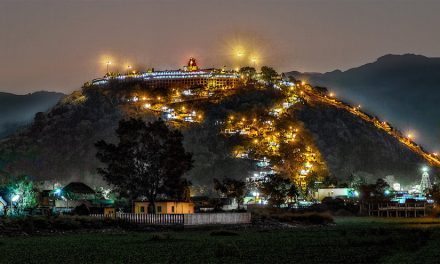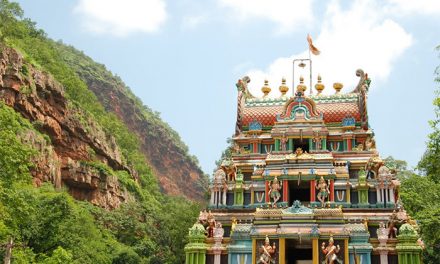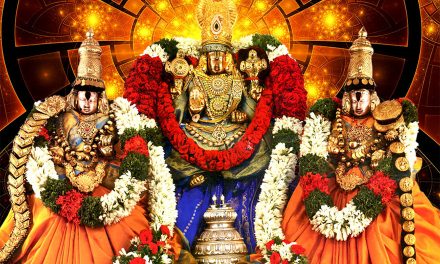Another of Andhra Pradesh’s famous temple abodes of Lord Narasimhadev is found in the Nalgonda region, in the town of Yadagirigutta, 70 kms from Hyderabad. Because the sage Yadarishi is said to have been granted his wish to see the Lord here, the place became known by the name Yadagiri (giri means hill in Sanskrit, and gutta, which means hillock in Telugu. (The “gutta” seems to have been a latter-day suffix.) Being reputed as a place of worship for the sages, Yadagirigutta is also known as Rushi Aradhana Kshetram.
The sanctum is a natural cave on the Yadagiri hill. Jwala Narasimha (the Lord of flame), Ghandabheranda Narasimha (without an image) and Yoga Narasimha are all worshipped here, in addition to a silver Deity of Lakshmi-Narasimha and a shrine to Aandaalamma.
Two rock formations in the sanctum wall are revered as Jwala Narasimha and Yoga Narasimha respectively. The Jwala Narasimha resembles a serpent, while the Yoga Narasimha image is Lord Narasimha’s Form in meditation. In His form of Yoga Narasimha, it is understood that the Lord grants healing, both physical and of spiritual benefit, to His sincere aspirants.
The temple is at a height of 300 feet on Yadagiri hill. It is said that the sacred Vedas took the form this hill so as to bear upon its head the Yogananda Narasimhaswamy. On the foothill there is Vaikuntha Dwara entrance, which features a shrine to Sri Hanuman. There is also a gap in the rock representing Ghandabheranda Narasimha. Also on Yadagiri hill is a temple dedicated to worship of Lord Shiva.
History of the Temple
There are Puranic and traditional accounts of this Sri Narasimhadev shrine, with mention of the origin of this temple in the Skanda Purana.
In Tretayugam, there lived a sage named Yadarishi, who was the son of the great sage Rishyasrunga and Santa Devi, who did penance inside a cave with the blessings of Anjaneya on the hill between Bhongir (Bhuvanagiri) and Raigiri (now in Nalgonda district). Pleased with the sage’s deep devotion, Lord Narasimha appeared before him in five different forms, as Jwala, Yogananda, Gandabherunda, Ugra and Lakshmi-narasimha. These five Form later manifested Themselves into the finely sculpted forms that came to be worshipped as Pancha-narasimha Kshetram.
Known as the Pancha Narasimha Kshetra, this holy dhama lies on the bank of the River Krishna. There are several independent temples existing at different places, the principal one of which is the shrine of Yogananda Lakshmi Narasimhaswamy. There are two separate mandirs for Rajyalakshmidevi and Godadevi, both elegantly built. There is another shrine for Lakshmi Narasimhaswamy, the second of the five dedicated to the Lord. The third one, an ant-hill is found on the top of the hill and is called Jwalanarasimhaswamy. The fourth one is said to be a Salagram From in the River Krishna, which only gives Darshan when the river recedes backwards. The fifth one is found on the hill called Garudachalam, which lies a short distance away. The deity is called by two names – Vugranarasimhaswamy and Viranarasimhaswamy. All these places are exercising a great pull on the hearts of the Nrsimha-bhaktas.
At Yadagiri hill, the Lord appeared first as Jwala Narasimha. When Yadarishi was unable to face the intensity of this manifestation, the Lord appeared in a peaceful form as Yoganarasimha (in a padmasana posture with open palms on His knees). Not satisfied with the Lord appearing alone, Yadarishi desired to see Him with His consort, so the Lord is said to have appeared with Lakshmi on his lap, thus He is known as Lakshmi Narasimha Swamy.
To see these three forms, pilgrims go through an entrance that narrows down into a dark cave. The cave is under a large rock which forms a sloping roof, about five feet high in the middle. Pilgrims must duck their heads to get through the formation, thus involuntarily bowing to the Lord.
At the end of the cave are the actual images of the Lord. Two rocks are fastened to each other and form a vertical cup. On the other side of the rock is found an image in the shape of a serpent head, ending like its tail. This is said to be the aspect of God known as Jwala Narasimha. It is said that a divine serpent still moves about the temple image.
On the opposite rock, is the Yogananda Narasimha image of the Lord, along with the third manifestation as Lakshmi Narasimha, which appears on the same rock. The fourth form, Ugra Narasimha, reveals His Fierce Mouth at the wide entrance to the cave, because it was beyond the strength of the sage to see that Form.
Gandabherunda (the garuda pakshi) is the fifth Form of the Lord, which is said to have been found sculpted in rock underneath the Anjaneya, known as ‘Kshetrapalaka’, or the One Who ruled over that hill). This form is known only by the presence of an eternal lamp that burns within a crevice beneath Sri Anjaneya sannidhi. All these forms are known as swayambhu or self-emanated.
As these rupams of the Lord are sometimes difficult to see in the small crevices inside the cavern that serves as His sannidhi, Lord Narasimha and Lakshmi also stand together as large silver utsava murthis as Sri Lakshmi-Narasimha. It is this Form of the Lord that is best known and most often worshipped by devotees at the temple. The Lord’s hand is raised in the abhaya dana mudra, granting fearlessness.
Standing brilliantly atop the sikharam of garbha griha (sanctum sanctorum) of the temple is a golden Sudarshana chakra of the Lord. It measures about 3 ft. x 3ft., and can be seen up to 6 km. Away. It is said that many years ago, the chakra moved in the direction from which the devotees came as if it were a compass guiding them towards the Lord.
With respect to Sri Yogananda Narasimhaswamy’s great mercy on the devotees, one account describes it as follows: “Over the centuries, and particularly in recent years, Sri LakshmiNarasimhan has revealed an interesting side of His Compassionate Nature by taking on the role of a Divine Doctor. Many devotees tell of vivid dreams in which the Lord comes to heal them from chronic or terminal illnesses, and even mental or emotional problems. Often times, the Lord Himself has imparted mantropadesham to select devotees in their dreams. Those visiting the temple have often come out of an overwhelming desire to be there, and just as mysteriously, those leaving the temple leave with the knowledge and satisfaction that their illnesses have been cured; a feeling that is often proved true upon their next visit to their family physician. It is for this reason that the Lord has come to be known as Sri Vaidya Lakshmi-Narasimhan.”
Temple Activities
The Aradhanam and puja at this temple are performed according to Pancharatra Agamam. The puja vidhanam (Puja procedure) was set by Late Sri Vangeepuram Narasimhacharyulu, who composed Yadagiri Suprabhatam, Prapatti, Stotram, Mangalashasanam and served as Sthanacharya of this temple. Vaikhanasa agama worship is offered in all the Panchanarasimha kshetras.
The Kalyanotsav falling in the month of Vaisakha Suddha Eakadasi is celebrated on a grand scale. Another annual festival that lures huge crowds of devotees here is Narasimha Jayanthi. Besides the locals, thousands from far off places too visit on account of its antiquity and the ease of accessibility to the Lord.















I am blessed to have had HIS DARSHAN twice ,Namo Namo Yadagiri Devaya Namaha!!!! And today retraced and relived the Darshan……